
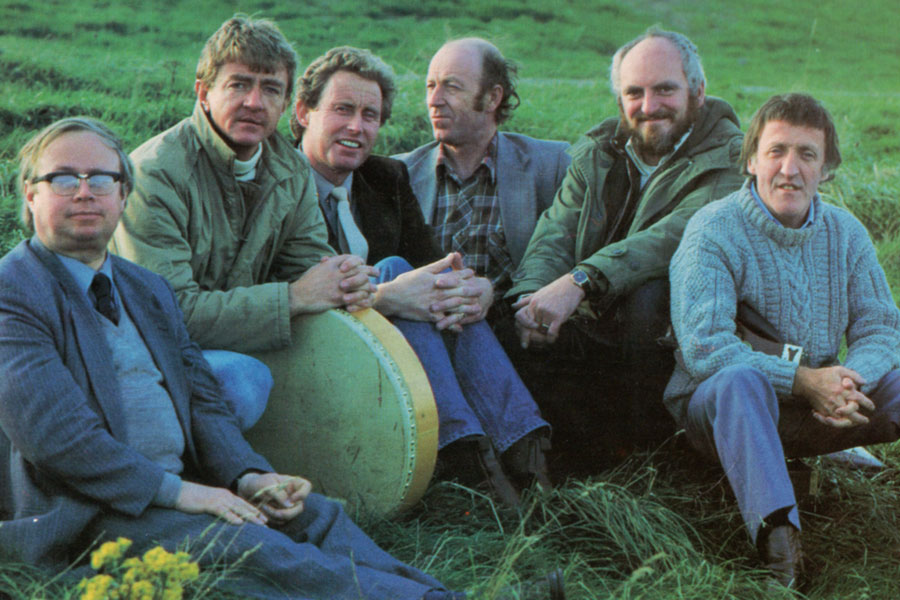
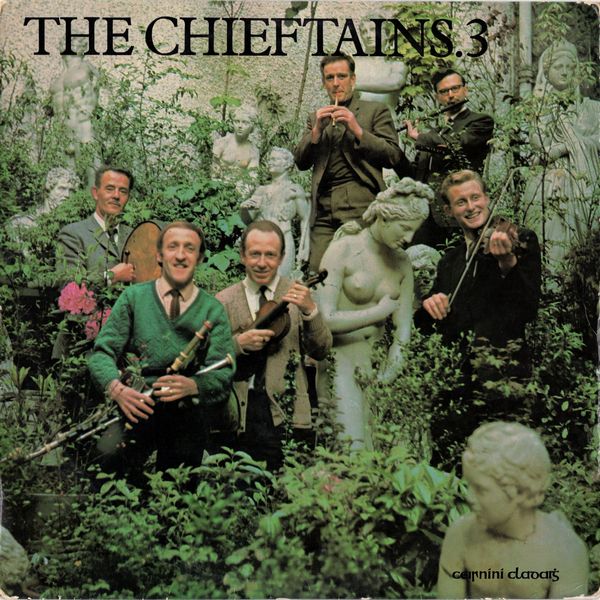 |
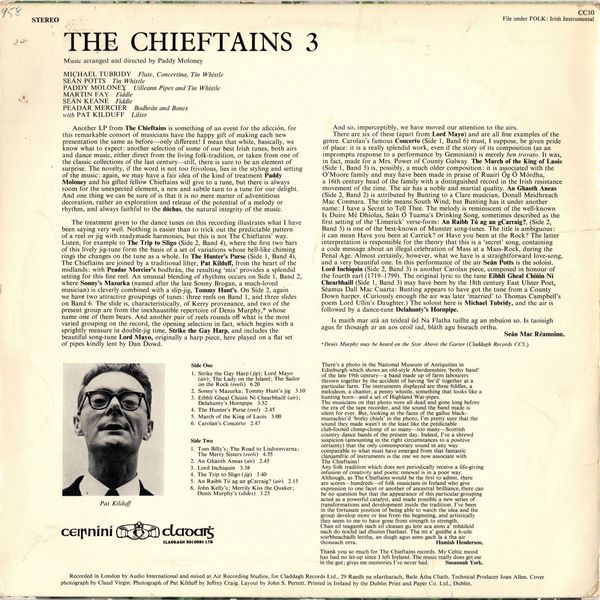
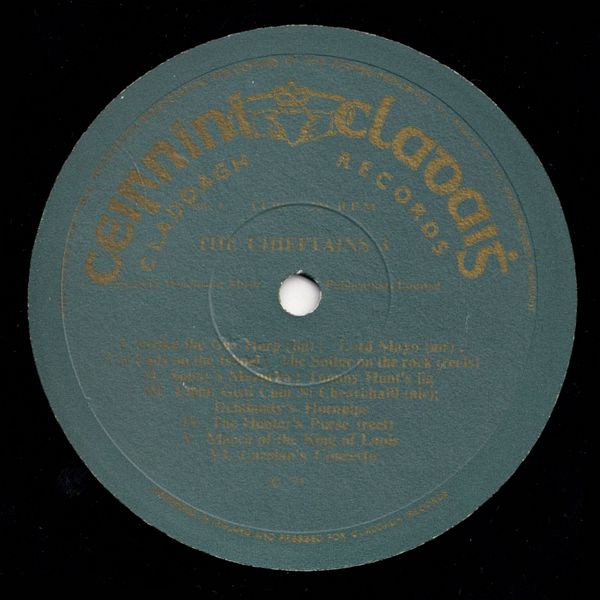
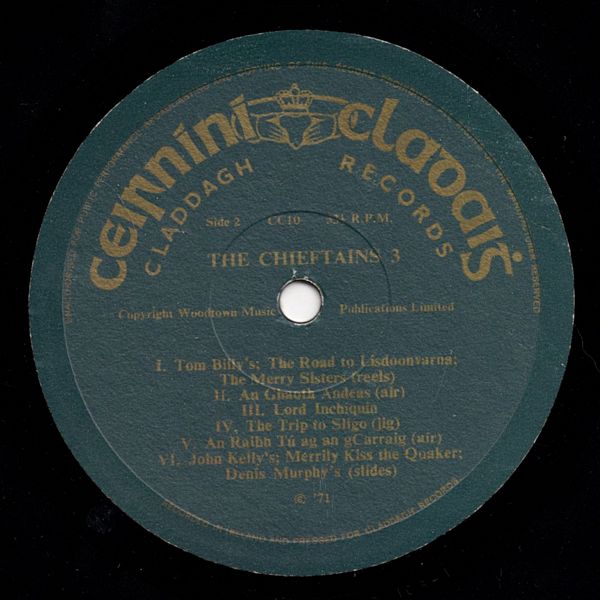 |
Sleeve Notes
Another record from The Chieftains is something of an event for the aficcién, for this remarkable consort of musicians have the happy gift of making each new presentation the same as before — only different! I mean that while, basically, we know what to expect: another selection of some of our best Irish tunes, both airs and dance music, either direct from the living folk-tradition, or taken from one of the classic collections of the last century — still, there is sure to be an element of surprise. The novelty, if the word is not too frivolous, lies in the styling and setting of the music; again, we may havea fair idea of the kind of treatment Paddy Moloney and his gifted fellow Chieftains will give toa tune, but there is always room for the unexpected element, anew and subtle turn to a tune for our delight. And one thing we can be sure of is that it is no mere matter of adventitious decoration, rather an exploration and release of the potential of amelody or rhythm, and always faithful to the duchas, the natural integrity of the music.
The treatment given to the dance tunes on this recording illustrates what I have been saying very well. Nothing is easier than to trick out the predictable pattern of a reel or jig with ready-made harmonies, but this is not The Chieftains' way. Listen, forexample to The Trip to Sligo (side 2, band 4), where the first two bars of this lively jig-tune form the basis of a set of variations whose bell-like chiming rings the changes on the tuneasa whole. In The Hunter's Purse (side 1, band 4), The Chieftains are joined by a traditional lilter, Pat Kilduff, from the heart of the midlands: with Peadar Mercier's bodhran, the resulting 'mix' provides a splendid setting for this fine reel. An unusual blending of rhythms occurs on side 1, band 2, where Sonny's Mazurka (named after the late Sonny Brogan, a much-loved musician) is cleverly combined with a slip-jig Tommy Hunt's. On side 2, again we have two attractive groupings of tunes: three reels on band I, and three slides on band 6. The slide is, characteristically, of Kerry provenance, and two of the present group are from the inexhaustible repertoire of Denis Murphy,* whose name one of them bears. And another pair of reels rounds off what is the most varied grouping on the record, the opening selection in fact, which begins with a sprightly measure in double-jig time, Strike the Gay Harp, and includes the beautiful song-tune Lord Mayo, originally a harp piece, here played ona flat set of pipes kindly lent by Dan O'Dowd.
And so, imperceptibly, we have moved our atterition to the airs. There are six of these (apart from Lord Mayo) and all are fine examples of the genre.
Carolan's famous Concerto (side 1, band 6) must, I suppose, be given pride of place: it is a really splendid work, even if the story of its composition (as an impromptu response to a performance by Geminiani) is merely ben trovato. It was, in fact, made for a Mrs Power of County Galway. The March of the King of Laois (side 1, band 5) is, possibly, a much older composition: it is associated with the O' Moore family and may have been made in praise of Ruairi Og O Mordha, a 16th century head of the family with a distinguished record in the Irish resistance movement of the time. The air has a noble and martial quality. An Ghaoth Aneas (side 2, band 2) is attributed by Bunting toa Clare musician, Donall Meidhreach Mac Conmara. The title means south wind, but Bunting has it under another name: I havea Secret to Tell Thee. The melody is reminiscent of the well-known, Is Duine Mé Dhiolas Leann La, Seán O Tuama's drinking song, sometimes described as the first setting of the 'Limerick' verse-form: An Raibh Tu ag an gCarraig? (side 2, band 5) is one of the best-known of Munster song-tunes. The title is ambiguous: it can mean, Have you been at Carrick? or, Have you been at the Rock? The latter interpretation is responsible for the theory that this is a 'secret song, containing a code message about an illegal celebration of Mass at a Mass-Rock, during the Penal Age. Almost certainly, however, what we have is a straightforward love-song, and a very beautiful one. In this performance of the air Seán Potts is the soloist. Lord Inchiquin (side 2, band 3) is another Carolan piece, composed in honour of the fourth earl (1719-1799). The original lyric to the tune Ezbhli Gheal Chiuin Ni Chearbhaill (side 1, band 3) may have been by the 18th century east Ulster poet, Séamus Dali Mac Cuarta: Bunting appears to have got the tune from a County Down harper. (Curiously enough the air was later 'married' to Thomas Campbell's poem, Lord Ullin's Daughter.) The soloist here is Michael Tubridy, and the air is followed by a dance-tune Delahunty's Hornpipe.
Seán Mac Réamoinn
There's a photo in The National Museum of Antiquities in Edinburgh which shows an old-style Aberdeenshire 'bothy band' of the late 19th century — a band made up of farm labourers thrown together by the accident of having 'fee'd' together at a particular farm. The instruments displayed are three fiddles, a melodeon, a chanter, a penny whistle, something that looks like a hunting horn — and aset of Highland warpipes.
'The musicians on that photo were all dead and gone long before the era of the tape recorder, and the sound the band madeis silent for ever. But, looking at the faces of the gallus black-mustachio'd 'bothy chiels' in the photo, I'm pretty sure that the sound they made wasn't in the least like the predictable club-footed clomp-clomp of so many — too many — Scottish country dance bands of the present day. Indeed, I'vea shrewd suspicion (amounting in the right circumstances to a positive certainty) that the only contemporary sound in any way comparable to what must have emerged from that fantastic clamjamphrie of instruments is the one we now associate with The Chieftains!
Any folk tradition which does not periodically receive a life-giving infusion of creativity and poetic renewal is in a poor way. Although, as The Chieftains would be the first to admit, there are scores — hundreds — of folk musicians in Ireland who give expression to one facet or another of ancestral brilliance, there can be no question but that theappearance ofthis particular grouping acted as a powerful catalyst, and made possible a new series of transformations and development inside the tradition. I've been in the fortunate position of being able to watch the idea and the group develop more or less from the beginning, and artistically they seem to me to have gone from strength to strength.
Hamish Henderson
Thank you so much for The Chieftains records. My Celtic mood has had no let-up since I left Ireland. The music really does get me in the gut; gives me memories I've never had.
Susannah York